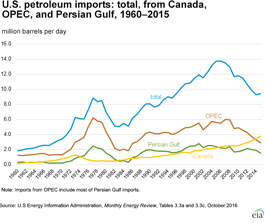Did you know?
OPEC and Persian Gulf countries are not the same.
The Organization of the Petroleum Exporting Countries (OPEC), was organized in 1960 for the purpose of negotiating with oil companies on matters of oil production, prices, and future concession rights. Of the 12 countries in OPEC in 2015, only 6 of them were in the Persian Gulf.
| OPEC | Persian Gulf |
|---|---|
|
|
The United States produces a large share of the petroleum it consumes, but it still relies on imports to help meet demand
In 2015, the United States produced1 about 14.8 million barrels per day (MMb/d) of petroleum, and it consumed2 about 19.5 MMb/d of petroleum. Imports help to supply the demand for petroleum.
Petroleum includes more than just crude oil
Petroleum includes more products than just crude oil. Petroleum includes refined petroleum products such as gasoline, diesel fuel, jet fuel, unfinished oils, and other liquids such as fuel ethanol, blending components for gasoline, and other refinery inputs.
In 2015, the United States imported nearly 7.4 MMb/d of crude oil and slightly more than 2 MMb/d of petroleum liquids and refined petroleum products, for a total of about 9.4 MMb/d of petroleum imports.
U.S. reliance on petroleum imports has declined in recent years
U.S. petroleum imports have declined since peaking in 2005. This trend is the result of many factors, including a decline in consumption, increased use of domestic biofuels (ethanol in gasoline and biodiesel in diesel fuel), and increased domestic production of crude oil and hydrocarbon gas liquids. The economic downturn following the financial crisis of 2008, improvements in vehicle fuel economy, and changes in consumer behavior contributed to the decline in U.S. petroleum consumption.
The amount of net imports (imports minus exports) of petroleum relative to the amount of petroleum consumed is one measure of our reliance on imports to help meet petroleum demand. Net imports of petroleum averaged 4.7 MMb/d, the equivalent of 24% of total U.S. petroleum consumption in 2015, the lowest level since 1970.
Share of imports from OPEC and Persian Gulf countries has declined, while the share for imports from Canada has increased
U.S. petroleum imports rose sharply in the 1970s, especially from nations that comprise the Organization of the Petroleum Exporting Countries (OPEC). In 1977, when the United States exported relatively small amounts of petroleum, OPEC nations were the source of 70% of total U.S. petroleum imports. Since 1977, the share of OPEC imports to the United States has generally declined. In 2015, OPEC's share of total U.S. petroleum imports was about 31%. Saudi Arabia was the source of about 37% of OPEC imports, and Venezuela was the source of about 29% of OPEC imports.
In 2015, about 16% of U.S. petroleum imports came from the Persian Gulf countries, with Saudi Arabia the source of 70% of Persian Gulf imports.
The share of U.S. petroleum imports from Canada has increased significantly. Canada supplied 15% of U.S. petroleum imports in 1994. This share increased to 40% in 2015, and it represents the largest share of U.S. petroleum imports from any country.
The five largest sources of U.S. petroleum imports by share of total imports in 2015:
- Canada—40%
- Saudi Arabia—11%
- Venezuela—9%
- Mexico—8%
- Colombia—4%
The United States is a net exporter of petroleum products, and it also exports some crude oil
Because the United States imports about 2 MMb/d of petroleum liquids and refined products, it may seem surprising that it also exports petroleum liquids and refined products. In 2015, the United States exported about 4.3 MMb/d of total petroleum liquids and refined products, which made the United States a net exporter (exports minus imports) of petroleum liquids and refined products. The United States also exported about 0.5 MMb/d of crude oil, 92% of which went to Canada.
Most U.S. petroleum exports are petroleum liquids and refined products. Because of logistical, regulatory, and quality considerations, exporting some petroleum products is the most economical way to meet the market's needs. For example, refiners in the U.S. Gulf Coast region frequently find that it makes economic sense to export some of their gasoline to Mexico rather than shipping it to the East Coast of the United States, because lower-cost gasoline imports are available to the East Coast from Europe.
The five largest destinations of U.S. petroleum exports of 4.7 MMb/d by share of total exports in 2015:
- Canada—20%
- Mexico—15%
- Netherlands—5%
- China—4%
- Brazil—4%
Does the U.S. Energy Information Administration (EIA) know which companies purchase imported crude oil or gasoline?
Although EIA cannot identify which companies sell imported gasoline or gasoline refined from imported oil, it does publish data on the companies that import crude oil and refined products. However, the fact that a given company imported crude oil or gasoline does not mean that those particular imports will end up being sold to motorists as that company's brand of gasoline. Gasoline from different refineries is often combined for shipment by pipeline, and different companies owning service stations in the same area may be purchasing gasoline at the same bulk terminal.
1Production includes total petroleum field production, renewable fuels and oxygenate plant net production, and refinery processing gain.
2Consumption equals product supplied.






